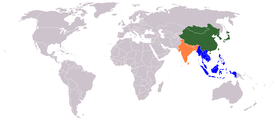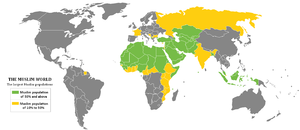- East–West dichotomy
-
An image of the "Eastern world" defined as Asia and the "Far East", consists of three overlapping cultural blocks: East Asia, Southeast Asia, and South Asia.

The East-West dichotomy is a sociological concept used to describe perceived differences between Western cultures and the Eastern world. Cultural rather than geographical in division, the boundaries of East and West are not fixed, but vary according to the criteria adopted by individuals using the term. Historically, Islamic and Asian nations have been regarded as East, while the United States and Western Europe are regarded as West. Used in discussing such studies as management, economics and linguistics, the concept is criticized for overlooking regional hybridity.
Contents
Divisions
Conceptually, the boundaries are cultural, rather than geographical, as a result of which Australia is typically grouped in the West, while Islamic nations are regardless of location grouped in the East.[1] The culture line can be particularly difficult to place in regions of cultural diversity such as Bosnia and Herzegovina, whose citizens may themselves identify as East or West depending on ethnic or religious background.[1] Further, residents of different parts of the world perceive the boundaries differently; for example, Western Europeans have traditionally defined Russia as East, while Islamic nations regard it and other predominantly Christian nations as West.[1]
History
The concept has been utilized in both "Eastern" and "Western" nations. Japanese sinologist Tachibana Shiraki in the 1920s wrote of the need to unify with China and some other Asian nations (excluding Central Asia and the Middle East) in forming a "New East" that might combine culturally in balancing against the West.[2] Japan continued to make much of the concept through World War II, in propaganda.[3] In China, it was encapsulated during the Cold War in a 1957 speech by Mao Zedong,[4] who launched a slogan when he said, "This is a war between two worlds. The West Wind cannot prevail over the East Wind; the East Wind is bound to prevail over the West Wind.[5]
To Western writers, in the 1940s it became bound up with an idea of aggressive, "frustrated nationalism", which was seen as "intrinsically anti- or non-Western"; sociologist Frank Furedi writes that "The already existing intellectual assessment of European nationalism adapted to the growth of the Third World variety by developing the couplet of mature Western versus immature Eastern nationalism.... This East-West dichotomy became an accepted part of Western political theory."[6] The 1978 book Orientalism by Edward Said was highly influential in further establishing concepts of the East-West dichotomy in the Western world, bringing into college lectures a notion of the East (vaguely defined as stretching from Japan to the Arab World) as "characterized by religious sensibilities, familial social orders, and ageless traditions" in contrast to Western "rationality, material and technical dynamism, and individualism."[7]
More recently, the divide has also been posited as an Islamic "East" versus an American and European "West."[8][9] Critics note that an Islamic/non-Islamic East-West dichotomy is complicated by the global dissemination of Islamic fundamentalism and by cultural diversity within Islamic nations, moving the argument "beyond that of an East-West dichotomy and into a tripartite situation".[10]
Applications
The East-West dichotomy has been utilized in studying a range of topics, including management, economics and linguistics. 2007's Knowledge Creation and Management examines it as the difference in organizational learning between Western cultures and the Eastern world.[11] It has been widely utilized in exploring the period of rapid economic growth that has been termed the "East-Asian miracle" that occurred in segments of East Asia, and particularly the group known as the Asian Tigers, following World War II.[12] Some sociologists, in line with the West as a model of Modernity posited by Arnold Toynbee, have perceived this economic expansion as a sign of the "Westernization" of the region, while others look for explanation in cultural/racial characteristics of the East, embracing concepts of fixed Eastern cultural identity in a phenomenon described as "New Orientalism".[1][13] Both of these approaches within the East-west dichotomy have been criticized for failing to take into account the historical hybridity of the regions.[14]
The concept has also been brought to bear on examinations of intercultural communication. The Chinese are widely described as embracing an "inductive speech pattern", whereby a primary point is approached indirectly, while Western societies are said to utilize "deductive speech" in which speakers immediately establish their point.[15] This is attributed to a higher priority among the Chinese in harmonious interrelations, while Westerners are said to prioritize direct communication.[16] 2001's Intercultural Communication: A Discourse Approach described the East-West dichotomy linguistically as a "false dichotomy", noting that both Asian and Western speakers utilize both forms of communication.[17]
Criticism
In addition to difficulties in defining regions and overlooking hybridity, the East-west dichotomy has been criticized for creating an artificial construct of regional unification that allows one voice to claim authority to speak for multitudes. In "The Triumph of the East?", Mark Berger speaks to the issue as relates to examination of the East-Asian miracle:
The historical power of the East-West dichotomy, and the fixed conceptions of culture/race to which it is linked, have increasingly allowed the national elites of the region to speak not only for their 'nations,' but even for Asia and Asians.... There are numerous instances of Western scholars, intent on challenging North American and/or Western hegemony in both material and discursive terms, ending up uncritically privileging the elite narratives of power-holders in Asia as authentic representatives of a particular non-Western nation or social formation (and also contributing to the continued use of the East-West dichotomy).[18]
References
- ^ a b c d Meštrovic, Stjepan (1994). Balkanization of the West: The Confluence of Postmodernism and Postcommunism. Routledge. p. 61. ISBN 0203344642.
- ^ Li, Lincoln (1996). The China factor in Modern Japanese thought: the case of Tachibana Shiraki, 1881-1945. Suny Series in Chinese Philosophy and Culture. SUNY Press. pp. 104–105. ISBN 0791430391.
- ^ Iriye, Akira (2002). Global community: the role of international organizations in the making of the contemporary world. University of California Press. p. 87. ISBN 0520231279.
- ^ Kau, John K.; Leung (1992). "Notes". The Writings of Mao Zedong, 1949-1976: January 1956-December 1957. Writings of Mao Zedong. 2. M.E. Sharpe. p. 773. ISBN 0873323920.
- ^ Zedong, Mao (1992). Kau, Michael Y. M.; Leung, John K.. eds. The Writings of Mao Zedong, 1949-1976: January 1956-December 1957. Writings of Mao Zedong. 2. M.E. Sharpe. p. 775. ISBN 0873323920.
- ^ Füredi, Frank (1994). Colonial wars and the politics of Third World nationalism. I.B.Tauris. pp. 115–116. ISBN 185043784.
- ^ Barnett, Suzanne Wilson; Van Jay Symons (2000). Asia in the undergraduate curriculum: a case for Asian studies in liberal arts education. East Gate. M.E. Sharpe. p. 99. ISBN 0765605465.
- ^ Meštrovic, 63.
- ^ See also Chahúan, Eugenio (2006). "An East-West dichotomy: Islamophobia". In Schenker, Hillel; Ziad, Abu Zayyad. Islamophobia and anti-Semitism. A Palestine-Israel Journal Book. Markus Wiener Publishers. pp. 25–32. ISBN 1558764038.
- ^ Khatib, Lina (2006). Filming the modern Middle East: politics in the cinemas of Hollywood and the Arab world. Library of Modern Middle East Studies, Library of International Relations. 57. I.B.Tauris. pp. 166–167, 173. ISBN 1845111915.
- ^ Ichijō, Kazuo; Ikujirō Nonaka (2007). Knowledge creation and management: new challenges for managers. Oxford University Press US. p. 280. ISBN 0195159624.
- ^ Norberg, Johan (2003). In defense of global capitalism. Cato Institute. p. 99. ISBN 1930865465.
- ^ Berger, Mark T. (1997). "The triumph of the East? The East-Asian Miracle and post-Cold War capitalism". In Borer, Douglas A.. The rise of East Asia: critical visions of the Pacific century. Routledge. pp. 260–261, 266. ISBN 0415161681.
- ^ Berger, 275.
- ^ Cheng, Winnie (2003). Intercultural conversation. Pragmatics & Beyond. 118. John Benjamins Publishing Company. p. 51. ISBN 9027253609.
- ^ Cheng, 53.
- ^ Scollon, Ronald (2001). Intercultural communication: a discourse approach. Language in Society. 21 (2 ed.). Wiley-Blackwell. pp. 94–95. ISBN 0631224181.
- ^ Berger, 276
Categories:- Cultural spheres of influence
- International relations theory
- Political theories
- Dichotomies
Wikimedia Foundation. 2010.


